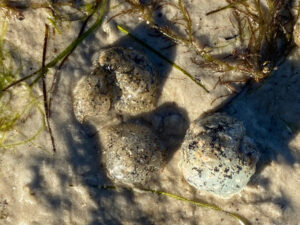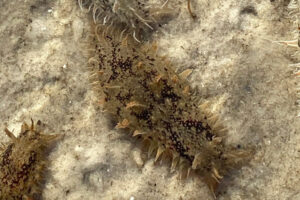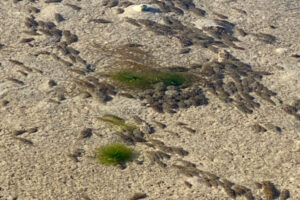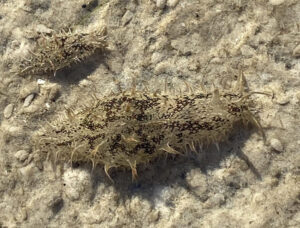Hares! Here, there and everywhere. I seem to be finding hares everywhere. I live in the Sonoran Desert with the very large rabbits known as desert hares. The actual common name is Antelope Jackrabbit with the scientific name of Lepus alleni. I’ve tried many times to get a photo of a jackrabbit with its long, pointed ears, but they are very wary and take off before my cell photo camera can focus. This really large rabbit is found in the deserts of southern Arizona and northwestern Mexico. They prefer an area with some grass and mesquite trees. Whenever I’m out in the washes in the surrounding desert, I look for these incredible creatures.
The Hare of the Ocean
But the antelope jackrabbit isn’t the only hare I’ve been hanging with lately. After the flooding of my house in Fort Myers, FL, due to the storm surge of Hurricane Ian, I sought solace on Bunche Beach. I wanted to see life returning to normalcy after the storm’s destruction. I hoped the ocean had repaired its injuries and that I would find creatures crawling in the shore waters. Sadly, the plants along the shore were severely damaged and mostly killed.
I looked for the usual King’s crowns, Melongena corona, but they were missing along with the grass beds that they lived in. What I did find on the sand bars (it was low tide) were little round balls of jelly or what I thought were gelatinous algae.

But when I saw more of them in the puddles, they were elongated and gliding! I had never seen them before but suspected they were some sort of nudibranch. Using my handy iNaturalist app, these creatures were identified as the ragged sea hare or shaggy sea hare, Bursatella leachii. Sea hares are opisthobranchs or marine gastropod mollusks that have a small or missing shell. Nudibranchs are a kind of opisthobranchs. I was close in my guess.

When I stopped and surveyed the beach, I realized there were thousands of these sea hares either sliding over the sand or awaiting the returning waves.

A Hare Beach Party
Why were all these sea hares congregated on the beach? I’ve visited Bunche Beach for years, during different seasons, and never seen them. Believe me, I would have been excited by the presence of such interesting critters.
I guess that the hurricane’s winds and currents pushed them onto the beach. Another possibility is they were mating, but why now, for the first time? No, I suspect their presence is the result of the hurricane.
I didn’t perturb the mollusks. It turns out that they release purple ink when disturbed. If I had known that, I might have disturbed some. of them, just to see the purple ink.
Without the seagrass beds and being forced on the shore, I was worried about my new sea hare friends. What were they eating? Apparently, the sea hares eat cyanobacteria, so the lack of grass wasn’t a problem.
Many authors find the slugs unattractive. But I think they are quite attractive. There were some nice color variations.

However, what fascinated me the most was the way they were gliding across the sand, seemingly effortlessly, like hovercrafts zipping along. This movement will always be the sea slug slide to me.
I like the hares in my life, both on land and in the sea. Perhaps next will be flying hares! Is wishing for a flying hare, hare-e-sy? I am willing to admit to being a hare-a-tic and I definitely like my hares, here today and not gone tomorrow.
If you’d like to learn more about the wildlife on both the land and air, explore more hare-lariously fun and educational downloadable workbooks!
